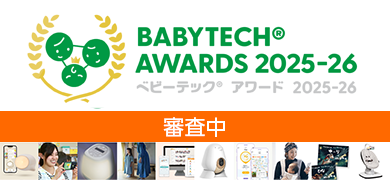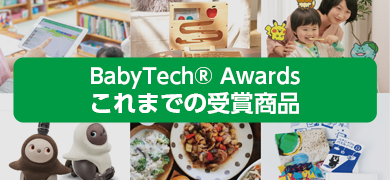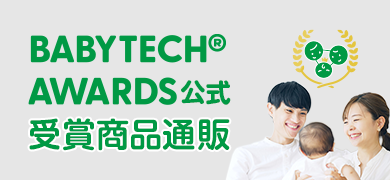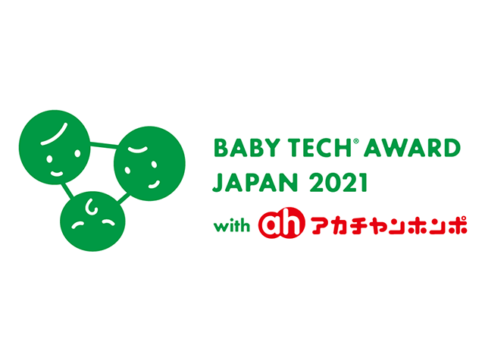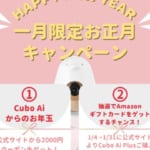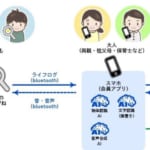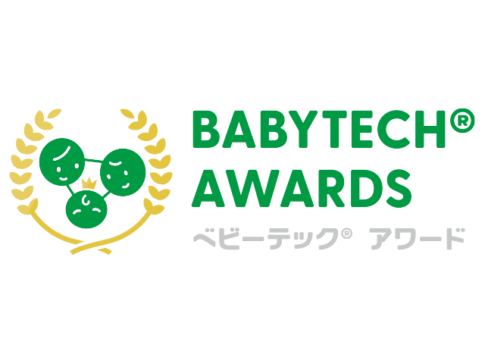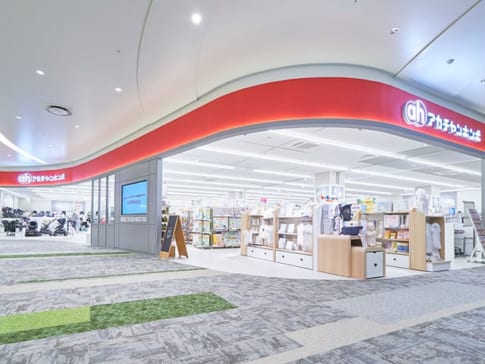- Monitoring the child's health throughout the day, not just during nap time
- Smartware" woven with silver-plated fibers enables accurate measurement of vital data
- Combines heart rate sensor, temperature sensor, and acceleration sensor to keep an eye on children
The "cocolin" introduced hereafter is a "wearable monitoring service" that combines "smart wear" and "monitoring devices". It monitors children's physical condition and stress throughout the day, not only during nap time, but also from the time they arrive at school to the time they leave. This product won the Noon Sleep Monitoring Device Award in the "BabyTech® Award Japan 2020 powered by DNP Dai Nippon Printing" and the Grand Prize in the "Safety Measures and Monitoring Category" of the "BabyTech® Award Japan 2021". The BabyTech.jp editorial department therefore interviewed Hironobu Shimazawa and Norio Koda (hereafter, titles omitted) of Kimuratan Corporation, the developer of Cocolin, to get an overview of the service, the development process, and future developments.
(We spoke to...)
Kimuratan Co.
Wearable Business Section
Hironobu Shimazawa

Norio Koda

Continuous monitoring of children's health throughout the day, from the time they arrive at school to the time they leave
Editorial:Thank you very much for your time today. Could you begin by giving us an overview of Cocolin and its features?
Shimazawa:Cocolin was developed to support childcare workers who are becoming extremely busy due to the diversification of childcare facilities. In particular, we are focusing on supporting childcare workers in their mission to ensure "safety and watch over children" and to provide "childcare and education". The actual service is a "solution to watch over children from the time they arrive at school to the time they leave," and the three components of this service are "smart wear," "transmitters," and a dedicated application.
First of all, "Smart Wear" is underwear for children, available in seven sizes from SS to 4L. The key point is that fabric woven with a special highly conductive silver-plated fiber is sewn into the chest area. This is where the children's vital data is measured, and through a device called a transmitter placed in a pocket at the bottom of the underwear, the children's information is entered into a dedicated application.
The transmitter is equipped with three sensors: a heart rate sensor, an acceleration sensor, and a temperature sensor. The transmitter sends information via Bluetooth to the "Cocolin Special Application" installed on an iPad or other tablet device, where it can watch over each child.
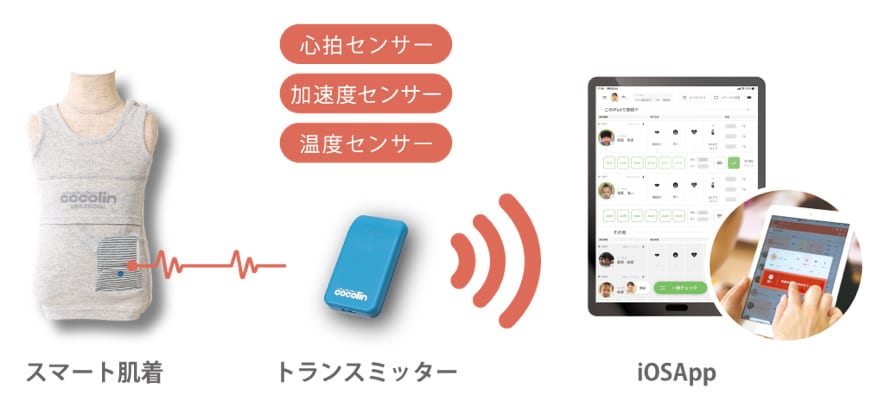
Editorial:Do you measure the children's body temperature at the silver-plated fiber you just asked about?
Koda:No. The silver-plated fibers are used to measure the heartbeats of the children. Body temperature is measured by the temperature sensor in the transmitter. It may be more accurate to say that the temperature sensor is measuring the "temperature inside the clothes" rather than the body temperature. This is the temperature between the child's body and the clothing. Generally speaking, the appropriate temperature inside clothing is around 32°C. However, in the case of infants and toddlers in particular, the temperature should be around 32°C. However, since infants and toddlers in particular have immature body temperature regulation functions, the temperature inside their clothing is greatly affected by the ambient and indoor temperatures.
If this continues to be outside of the proper values, a high or low body temperature can result. Therefore, Cocolin detects the temperature inside clothing and notifies the nursery staff of any abnormalities before heat stroke occurs.
Editorial:So the silver-plated fiber part is the sensor to measure the heart rate? How is the transmitter connected to the silver-plated fiber part?
Koda:The snap button for attaching the transmitter to the smart wear is the electrode that connects to the silver-plated fiber portion of the chest.
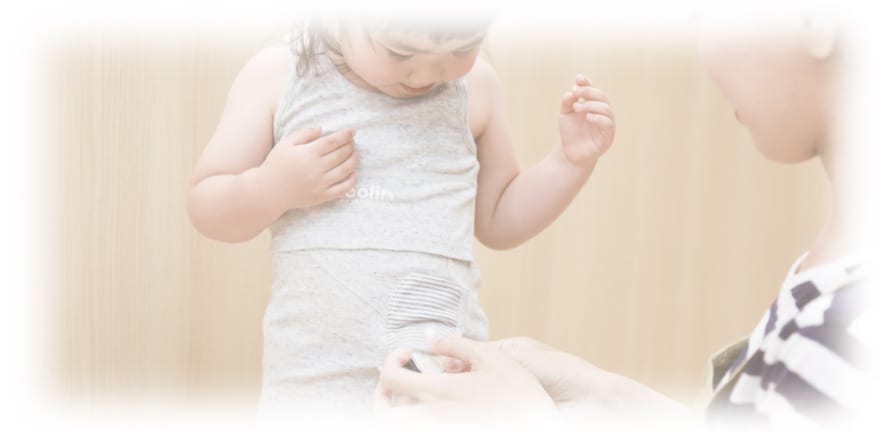
Shimazawa:Cocolin uses three tools to watch over children: a heart rate sensor, an acceleration sensor, and a temperature sensor. The heart rate sensor allows the user to see the children's heart rate from the moment it is attached until it is removed. The acceleration sensor mainly measures the posture of the child during a nap. It detects postures such as lying on one's back, face down, facing right, facing left, etc., and displays and records the status on a dedicated application. This also serves as a body motion sensor, and if it detects that the children have stopped moving for more than a certain period of time, it will issue an alert. The temperature sensor, as Koda mentioned earlier, measures the temperature inside clothing, with yellow alerts for fluctuations of 2 degrees Celsius or more, and red alerts for fluctuations of 3 degrees Celsius or more, which will be displayed on the app. The data and alerts that are being measured can be listed on the tablet device.
Comprehensive monitoring and analysis of various data to reduce the risk of SIDS
Editorial:There are a variety of products offered by various manufacturers for nocturnal sleep monitoring services, but what makes Cocolin unique?
Shimazawa:Stationary mat-type sensors and button-type sensors attached to clothing measure and record body movements, monitoring only during nap time. Cocolin, on the other hand, not only monitors posture and body movements during nap time, but also continuously monitors heartbeats and temperature changes inside clothing from the time children arrive at preschool in the morning to the time they leave.
For example, alerts can be issued when children are playing during the daytime and tend to suffer from heat stroke due to direct sunlight, when children who are not able to speak well develop stomach pains, or when they are stressed by external noise, etc. This is done by detecting the "stress level" of each child and notifying the user via a dedicated application as a physical condition alert or stress alert.
The purpose of nap watch is to prevent SIDS (Sudden Infant Death Syndrome), but to reduce the risk of SIDS, it is said that it is important not only to "avoid lying on the floor" but also to "be careful about the rise in temperature inside clothes due to overdressing" and "relieve stress in the early stages of caregiving. In fact, studies in Europe, the U.S., and Japan have shown that stress builds up in the early stages of childcare, and that the incidence of SIDS is extremely high there. Therefore, Cocolin detects and notifies data such as heartbeat, temperature inside clothing, and body movement from all angles from the time children arrive at preschool to the time they leave, especially during nap time, to enable childcare workers to be aware of any abnormalities in the children.

Koda:To add a little more detail, studies have shown that SIDS occurs more frequently during the winter months. The reason for this is that in the cold winter months, raising the room temperature too high and overclothing people with too much clothing can cause high body temperatures and depression, creating an environment that makes it easier for people to suffer from heat stroke in their clothing. Heat stroke not only raises the deep body temperature, but also decreases respiratory function and, in severe cases, causes impaired consciousness. Missing out on prone sleeping under such conditions is said to greatly increase the risk of developing SIDS. Cocolin's heat stroke detection algorithm, which uses temperature and heart rate sensors, enables it to immediately notify childcare workers if a tendency toward heat stroke is detected.
Editorial:What specific numbers, or rather what kind of things, does the sensor read when it says "detection of stress in the early stages of custody?"
Koda:Cocolin uses a heart rate sensor to measure the degree of tension between the sympathetic and parasympathetic nervous systems by analyzing the value of heart rate variability, which changes due to the effects of the autonomic nervous system. The balance of this tension level is used to detect stress in children. If this state of stress remains high for a certain period of time, the system alerts the childcare staff.
We also accumulate data on each child based on these three values of sympathetic and parasympathetic nerves and heart rate variability, and construct a unique health model for each child. We compare the health model of the day before with the health model of the day, and if a significant change is observed, this also informs the childcare staff of the unusual change in physical condition.
In fact, there was a very shocking report from the American Academy of Pediatrics that one-third of the children who died from SIDS died within one seedling period of being placed in daycare, and half of these children lost their lives on the first day they were placed there. This is not only the American Academy of Pediatrics, but there are also reports of similar trend values in Japan. In other words, the cause of SIDS is not yet known, but it is thought that "stress in the early days of care" may be an important factor .......
Against this backdrop, Cocolin is able to simultaneously monitor three of the most important factors in SIDS: "prone sleeping," "heat stroke, which is common in winter," and "stress in the early stages of custody. I believe that Cocolin's greatest strength and feature is that it not only detects "prone sleeping" and "body movement," but also stress and heat stroke related to SIDS based on vital data.
Significantly improved convenience through proprietary "smart wear," "transmitters," and "apps
Editorial:What kind of feedback have you received from users?
Shimazawa:Comments from nursery school nurses who have actually used the system include, "It helps prevent SIDS," and "It has improved my sense of security because I can visualize my child's physical condition and share it with other nursery school nurses. Another commented that the introduction of Cocolin has led to more frequent calls to the nursery staff during nap time, "Who is lying on his/her face," which has led to improved teamwork among nursery staff. Another commented that the new system has made it easier to create nap check sheets, which has improved their work efficiency and allowed them to spend more time on childcare. We are also happy to hear that many parents say that Cocolin is very easy to use, and that they were able to quickly get used to the application because it is so simple to operate. Furthermore, some parents commented, "I can rest assured that my child will be taken care of during nap time" and "I can rest assured that my child's condition will be taken care of throughout the day.
Editorial:In terms of the actual usage flow, would you imagine that each family would wear the smart wear to school and attach the transmitter at the daycare center?
Koda:You are right. Many families are happy to hear that they no longer have to wonder what to send their children to wear for underwear today, which in turn makes them happy. Since children grow up quickly, we provide a set of four free of charge every year. Therefore, there is almost no cost burden on the parents.

The service was born out of the fact that the company was an apparel manufacturer and nursery school operator
Editorial:Your company is originally an apparel manufacturer. How did you come up with such a revolutionary product?
Koda:We established a nursery school in our hometown of Kobe about three years ago and currently operate five nursery schools in Kobe and Osaka. In the course of continuing this nursery school business, we worked to develop Cocolin as a service that would lead to the safety of children and the peace of mind of their guardians. In addition, as the shortage of childcare workers has continued over the past few years, we have taken this service as far as reducing the workload of childcare workers in order to help them reduce their workload as much as possible.
Editorial:Were there any particular difficulties in the development of "smart wear"?
Koda:The "smart wear" on which it was based was a product for adults. It was used by athletes to manage their physical condition and analyze their peak performance, and was adapted for use on infants. The first problem was that children tend to wear loose-fitting clothes, but it is difficult to measure vitals unless they are firmly against the chest. Therefore, we struggled to find a way to make the garments fit the child to a certain degree. In addition, since the garment is for infants, we received feedback from nursery staff and parents on how to make it easier for them to wear the garment. Other innovations include the position of the pocket for attaching the transmitter and a special sewing technique to prevent stress on the seams. We have made numerous updates and the smartwear we currently offer is in its sixth generation.
Editorial:Is the transmitter battery operated?
Koda:It is rechargeable and operates for 24 hours on a 3-hour charge.

The company's "smart wear" will continue to evolve.
Editorial:Finally, can you tell us about your future plans?
Koda:We are aware that we are a very latecomer to this business. Therefore, we are considering what we can do because we are a latecomer, and are moving in the direction of further increasing convenience for childcare workers by collaborating with daycare ICT services such as CoDMON, a leading childcare ICT provider.
Editorial:Do you have any plans to add anything to the smart wear functionality?
Koda:I mentioned earlier about "temperature inside clothing," and we are considering changing the material of the garments and developing fabrics that can more easily absorb sweat and make nursery life more comfortable, with the aim of improving this.
After the interview
There are a variety of products and services available for devices that monitor nap time, and we felt that the "Cocolin" that we interviewed for this report is the definitive version of such a device. ...... Recently, wearable devices such as the Apple Watch have been introduced to monitor physical conditions. However, I believe that such devices are really needed in life-threatening settings such as daycare centers. I sincerely hope that this service will become more widespread and that the day will come when children can lead safer and healthier lives.
Cocolin" Official Website
https://coco-lin.jp/

